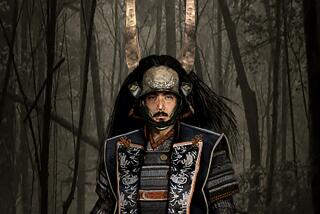Their Majesty
The accouterments of royalty have a captivating effect in conveying status and tradition that transcend time, geography and cultures. A modern example, of course, was Princess Diana, whose jewels, clothes--and escapades--fascinated the world. Other royalty, including her son Prince William and Japan’s Princess Masako, draw attention too.
African kings aren’t so familiar to the Western world. But the majesty and elegance of their native dress have been captured in Daniel Laine’s book “African Kings” (Ten Speed Press, 2000). The French photographer spent three years in his attempt to photograph 70 African kings.
“I was thinking of doing two things: the historic background of the kings . . . and ‘the look,’ a very nice, different and wonderful dress,” Laine, 51, said in a telephone interview from France. Some kings inherit their regalia from their ancestors; others have the clothes especially made for them in styles resembling those of ancient times. “They are really commercially untouched people.”
Laine describes in the book the obstacles he encountered in arranging to meet with the kings. He sometimes had to wait weeks for a meeting. A civil war made the journey to one king too difficult. Another monarch refused to speak with Laine over the phone, and the king of Swaziland refused to meet with him.
Even with these limits, his photographs provide riveting images of the tribal kings, many of whose dynasties have spanned hundreds of years.
He set out to capture the traditions and history of African monarchies.
“Western countries never speak of those [traditions]. They always speak about the bad things: AIDS, wars, dictatorships, people dying of hunger,” Laine said. “[In Africa] you have a very big fight between traditional power and political power, but the traditional power is still there. People have been through such bad experiences, they follow the traditions--a lot.”
For many of the kings, gold symbolizes their high position, because, according to Laine, “gold is a symbol meaning power to them. It means they are rich.”
In a portrait of Oseadeeyo Addo Dankwa III, the king of Akropong-Akuapem in Ghana, is dressed in gold and sits in an elaborate gold chair. At the edge of his feet sits a young boy, considered the king’s “okra,” or soul.
The child--said to protect the king from evil and disease--is a reminder of African traditions and the role of kings. Laine said, “They [may] be poor, barefooted, but they are still important for their people. They still get magical and traditional power from the people. I take [their photo] in their house, their place. I’m not doing a scenario. That’s exactly how I found them.”
More to Read
Sign up for our Book Club newsletter
Get the latest news, events and more from the Los Angeles Times Book Club, and help us get L.A. reading and talking.
You may occasionally receive promotional content from the Los Angeles Times.







